 W
WThe Tower of London, officially Her Majesty's Royal Palace and Fortress of the Tower of London, is a historic castle on the north bank of the River Thames in central London. It lies within the London Borough of Tower Hamlets, which is separated from the eastern edge of the square mile of the City of London by the open space known as Tower Hill. It was founded towards the end of 1066 as part of the Norman Conquest. The White Tower, which gives the entire castle its name, was built by William the Conqueror in 1078 and was a resented symbol of oppression, inflicted upon London by the new ruling elite. The castle was also used as a prison from 1100 until 1952, although that was not its primary purpose. A grand palace early in its history, it served as a royal residence. As a whole, the Tower is a complex of several buildings set within two concentric rings of defensive walls and a moat. There were several phases of expansion, mainly under kings Richard I, Henry III, and Edward I in the 12th and 13th centuries. The general layout established by the late 13th century remains despite later activity on the site.
 W
WThe 1974 Tower of London bombing happened on 17 July 1974 with the explosion of a 10-14 lb bomb in the White Tower of the Tower of London. The blast left one person dead and injured 41 people, with many having lost limbs and suffering severe facial injuries. The victim who lost her life was Dorothy Household. At the time the Tower was busy with tourists. A dozen of the injuries were children. A scaffolding company working on the tower when the bomb detonated were able to act immediately to form the evacuation, ensuring the wounded were taken out of the building to safety and could gain urgent medical attention. The bomb was placed next to a wooden carriage of an 18th-century bronze cannon inside the Mortar Room. The gun carriage was destroyed.
 W
WThe Yeomen Warders of Her Majesty's Royal Palace and Fortress the Tower of London, and Members of the Sovereign's Body Guard of the Yeoman Guard Extraordinary, popularly known as the Beefeaters, are ceremonial guardians of the Tower of London. In principle they are responsible for looking after any prisoners in the Tower and safeguarding the British crown jewels. They have also conducted guided tours of the Tower since the Victorian era.
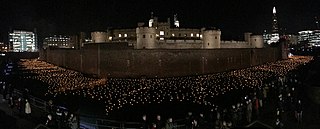 W
WBeyond the Deepening Shadow: The Tower Remembers was an artistic installation at the Tower of London in November 2018, to commemorate the centenary of the end of the First World War.
 W
WBlood Swept Lands and Seas of Red was a public art installation created in the moat of the Tower of London, England, between July and November 2014. It commemorated the centenary of the outbreak of World War I and consisted of 888,246 ceramic red poppies, each intended to represent one British or Colonial serviceman killed in the War. The ceramic artist was Paul Cummins, with conceptual design by the stage designer Tom Piper. The work's title was taken from the first line of a poem by an unknown soldier in World War I.
 W
WThe Ceremony of the Keys is an ancient ritual, held every evening at the Tower of London, when the main gates are locked for the night. It is said to be the oldest extant military ceremony in the world, and is the best-known ceremonial tradition of the Tower.
 W
WThe Chapel Royal of St Peter ad Vincula is the parish church of the Tower of London. It is situated within the Tower's Inner Ward, and the current building dates from 1520, although the church was established several centuries earlier. It is a Royal Peculiar. The name refers to Saint Peter's imprisonment under Herod Agrippa in Jerusalem. The Chapel is probably best known as the burial place of some of the most famous prisoners executed at the Tower, including Queen Anne Boleyn, Queen Catherine Howard and the nine-day Queen, Lady Jane Grey and her husband Lord Guilford Dudley, and Sir Thomas More.
 W
WThe Constable of the Tower is the most senior appointment at the Tower of London. In the Middle Ages a constable was the person in charge of a castle when the owner—the king or a nobleman—was not in residence. The Constable of the Tower had a unique importance as the person in charge of the principal fortress defending the capital city of England.
 W
WThe Crown Jewels of the United Kingdom, originally the Crown Jewels of England, are a collection of royal ceremonial objects kept in the Tower of London, which include the regalia and vestments worn by British kings and queens at their coronations.
 W
WThe Royal Fusiliers was a line infantry regiment of the British Army in continuous existence for 283 years. It was known as the 7th Regiment of Foot until the Childers Reforms of 1881.
 W
WGundulf was a Norman monk who went to England following the Conquest. He was appointed Bishop of Rochester and Prior of the Cathedral Priory there. He built several castles, including Rochester, Colchester and the White Tower of the Tower of London and the Priory and Cathedral Church of Rochester.
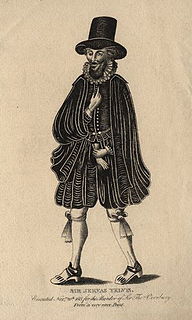 W
WSir Gervase Helwys, also known as Jervis Yelwys, was a Lieutenant of the Tower of London found guilty of complicity in the murder of Sir Thomas Overbury and hanged in 1615. The scandal provoked much public and literary conjecture and irreparably tarnished King James I's court with an image of corruption and depravity. There are variations in the spelling of Helwys: Helwis, Helwiss, Helewyse, Helwysse, Yelwys, Ellowis, Elwys, Elwis, Elvis, Elwes, and Elwaies.
 W
WThe Heralds' Museum was a museum of heraldry run by the College of Arms Trust at the Tower of London during the 1980s. It was situated in the old Waterloo Barracks within the Tower.
 W
WThe Jewel House is a vault housing the British Crown Jewels in the Waterloo Block at the Tower of London. It was opened by Queen Elizabeth II in 1994 and refurbished in 2012. Regalia have been kept in various parts of the Tower since the 14th century after a series of successful and attempted thefts at Westminster Abbey.
 W
WThe Lieutenant of the Tower of London serves directly under the Constable of the Tower. The office has been appointed at least since the 13th century. There were formerly many privileges, immunities and perquisites attached to the office. Like the Constable, the Lieutenant was usually appointed by letters patent, either for life or during the King's pleasure.
 W
WLittle Ease was a prison cell located beneath the White Tower in the Tower of London. The lightless cell was designed 1.2 metres on a side, meaning that while an adult human could be placed inside, any occupant was prevented from being able to either stand, sit, or lie down, meaning it was impossible for him to find any physical position of rest.
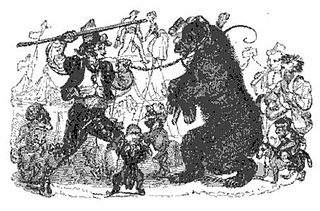 W
WOld Martin was a large grizzly bear given in 1811, when already full-sized, to George III by the Hudson's Bay Company. The bear was sent to the Royal Menagerie, housed at the Tower of London. Although this was the first grizzly bear in England, the king said he would rather have had been given a new tie or a pair of socks. The Royal Menagerie was closed in 1831 or 1832 by the Duke of Wellington, the governor of the Tower. The bear and other animals were moved to the new London Zoo in Regent's Park – Old Martin died there in 1838.
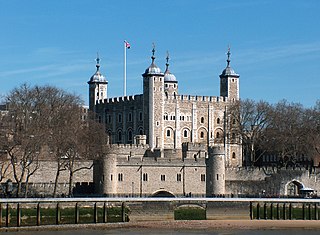 W
WFrom an early stage of its history, one of the functions of the Tower of London has been to act as a prison, though it was not designed as one. The earliest known prisoner was Ranulf Flambard in 1100 who, as Bishop of Durham, was found guilty of extortion. He had been responsible for various improvements to the design of the tower after the first architect Gundulf moved back to Rochester. He escaped from the White Tower by climbing down a rope which had been smuggled into his cell in a wine casket.
 W
WThe Ravens of the Tower of London are a group of at least six captive ravens resident at the Tower of London. Their presence is traditionally believed to protect The Crown and the Tower; a superstition holds that "if the Tower of London ravens are lost or fly away, the Crown will fall and Britain with it." Some historians, including the Tower's official historian, believe the "Tower's raven mythology is likely to be a Victorian flight of fantasy". The earliest known reference to captive ravens at the Tower is an illustration from 1883.
 W
WThe Royal Armouries is the United Kingdom's national collection of arms and armour. Originally an important part of England's military organization, it became the United Kingdom's oldest museum, originally housed in the Tower of London from the 15th century, and one of the oldest museums in the world. It is also one of the oldest and largest collections of arms and armour in the world, comprising the UK's National Collection of Arms and Armour, National Artillery Collection, and National Firearms Collection. Its historic base is in the Tower of London, but today the collection is split across three sites: the Tower, the Royal Armouries Museum in Leeds, and Fort Nelson near Portsmouth
 W
WThe Royal Mint is a government-owned mint that produces coins for the United Kingdom. Operating under the legal name The Royal Mint Limited, the mint is a limited company that is wholly owned by Her Majesty's Treasury and is under an exclusive contract to supply all the nation's coinage. As well as minting circulating coins for use domestically and internationally, the mint also produces planchets, commemorative coins, various types of medals and precious metal bullion. The mint exports to an average of 60 countries a year, making up 70% of its total sales. Formed over 1,100 years ago, the mint was historically part of a series of mints that became centralised to produce coins for the Kingdom of England, all of Great Britain and eventually most of the British Empire. The original London mint from which the Royal Mint is the successor was established in 886 AD and operated within the Tower of London for approximately 800 years before moving to what is now called Royal Mint Court where it remained until the 1960s. As Britain followed the rest of the world in decimalising its currency, the Mint moved from London to a new 38 acres (15 ha) plant in Llantrisant, Glamorgan, Wales, where it has remained since.
 W
WChristopher Skaife is Yeoman Warder Ravenmaster at the Tower of London. His responsibilities include the care and feeding for the ravens of the Tower of London.
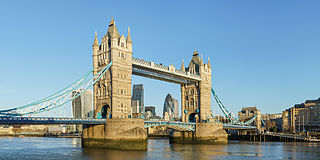 W
WTower Bridge is a Grade I listed combined bascule and suspension bridge in London, built between 1886 and 1894, designed by Horace Jones and engineered by John Wolfe Barry. The bridge crosses the River Thames close to the Tower of London and is one of five London bridges owned and maintained by the Bridge House Estates, a charitable trust founded in 1282. The bridge was constructed to give better access to the East End of London, which had expanded its commercial potential in the 19th century. The bridge was opened by Edward, Prince of Wales and Alexandra, Princess of Wales in 1894.
 W
WTower Gateway is a Docklands Light Railway (DLR) station in the City of London and is located near the Tower of London and Tower Bridge. It adjoins the tracks to Fenchurch Street station and is located on the site of a former station called Minories. Tower Gateway is within London fare zone 1.
 W
WTower Green is a space within the Tower of London, a royal castle in London, where two English Queens consort and several other British nobles were executed by beheading. It was considered more dignified for nobility to be executed away from spectators, and Queens Anne Boleyn, Catherine Howard and Lady Jane Grey were among the nobility beheaded here. Queen Victoria asked for information on the exact location where the executions took place and had some granite paving laid to mark the spot. However, it is unclear whether the location is indeed correct because other sources place it on the current parade ground between the White Tower and the entrance to the current Waterloo Barracks.
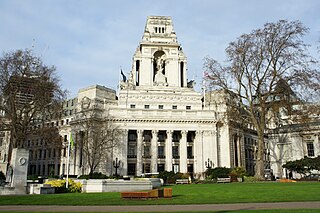 W
WThe name Tower Hill is primarily applied to the high ground just north of the Tower of London moat, in the London Borough of Tower Hamlets.
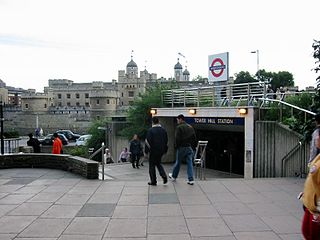 W
WTower Hill is a London Underground station in Tower Hill in the East End of London. It is on the Circle line between Monument and Aldgate stations, and the District line between Monument and Aldgate East. Tower Hill is within Travelcard zone 1 and is a short distance from Tower Gateway station for the Docklands Light Railway, Fenchurch Street station for National Rail mainline services, and Tower Millennium Pier for River Services.
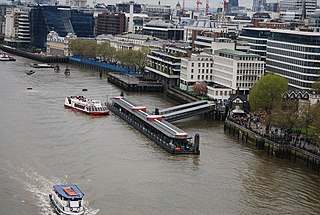 W
WTower Millennium Pier is a pier on the River Thames, in Tower Hill, London, England. It is operated by London River Services and served by various river transport and cruise operators. The pier is close to Tower Bridge and is situated immediately adjacent to the southwest corner of the Tower of London.
 W
WThe Liberties of the Tower, or the Tower Liberty is a small neighbourhood in the London Borough of Tower Hamlets, East London, which includes both Tower Hill and the Tower of London. The area was defined sometime after 1200 to provide an open area around the Tower to ensure its defensibility. The Liberty was an independent administrative unit from then until 1900, when it joined the former Metropolitan Borough of Stepney.
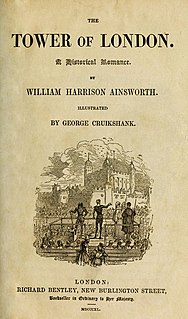 W
WThe Tower of London is a novel by William Harrison Ainsworth serially published in 1840. It is a historical romance that describes the history of Lady Jane Grey from her short-lived time as Queen of England to her execution.
 W
WThe Tower of London has been represented in popular culture in many ways. As a result of 16th and 19th century writers, the Tower has a reputation as a grim fortress, a place of torture and execution.
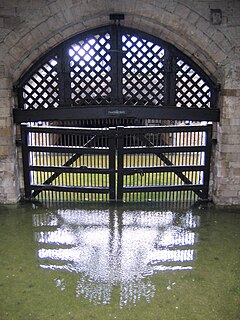 W
WThe Traitors' Gate is an entrance through which many prisoners of the Tudors arrived at the Tower of London. The gate was built by Edward I, to provide a water gate entrance to the Tower, part of St. Thomas's Tower, which was designed to provide additional accommodation for the royal family.
 W
WMrs. Anne Turner, aka Mistress Anne Turner or Mrs. Anne Turner, was the widow of a respectable London doctor who was hanged at Tyburn for her role in the famous 1613 poisoning of Sir Thomas Overbury referenced in the plays A New Trick to Cheat the Devil, The Widow, The World Tossed at Tennis and The City Nightcap.
 W
WThe White Tower is a central tower, the old keep, at the Tower of London. It was built by William the Conqueror during the early 1080s, and subsequently extended. The White Tower was the castle's strongest point militarily, and provided accommodation for the king and his representatives, as well as a chapel. Henry III ordered the tower whitewashed in 1240.
 W
WThe Keys, more frequently known as the Yeoman Warders Club, is a non-public pub in the Tower of London, in England, open only to the members of the Yeomen Warders, and their guests. The Yeomen Warders, who are known colloquially as the "Beefeaters", are the guards of the Tower of London; as of 2020 there were 37 Beefeaters. Beefeaters generally live in the Tower along with their families, which led to the existence of a dedicated pub. The current name of the pub, "The Keys", refers to a nightly locking-up ritual in the Tower; the name is a recent change, and the establishment was historically known as the Yeoman Warders Club. Though numerous pubs used to exist in the Tower, this is the only remaining one, and is about 150 years old.
 W
WThe Yeomen Warders of Her Majesty's Royal Palace and Fortress the Tower of London, and Members of the Sovereign's Body Guard of the Yeoman Guard Extraordinary, popularly known as the Beefeaters, are ceremonial guardians of the Tower of London. In principle they are responsible for looking after any prisoners in the Tower and safeguarding the British crown jewels. They have also conducted guided tours of the Tower since the Victorian era.
 W
W W
W